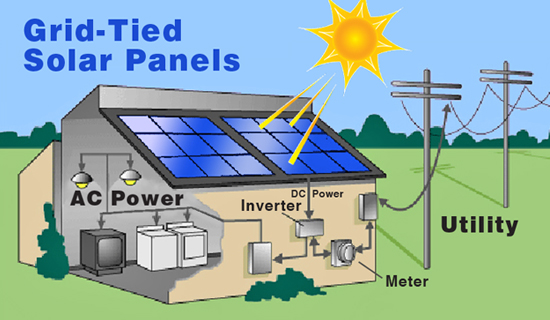How does Solar Power work?
The basic concept is that we put photovoltaic panels up on the roof and these convert sunlight into electricity which you can then use within the home. Any excess power is sold back to the grid.
There are no liquids being pumped around in tubes, in fact no moving parts at all, so the system is silent and largely maintenance free. Solar power systems last a long time - although we provide a generous warranty on the output of the panels for 30 years, the true life of the system is considerably longer than that - up to 40 + years.
The grid itself acts a bit like a giant communal battery. Any power that you produce that is in excess of your needs is exported back to the grid and you get credits for this. The amount you get paid varies a little between the major power companies. Your Solar Assessor can advise you on how to get the best result. If you are interested in having your own batteries at the same time then we can supply and install these too.

Panels
We use state of the art Trina Duomax solar panels. They are voted best in the world by Bloomberg, GlobalData and the Silicon Valley TC. Trina has been developing and exporting solar panels since 1997, more than 15 years longer than other competitors like LG. Their designs used toughened glass on both sides of the panel, while cheaper designs use a plastic backing and an aluminium frame which causes degradation and electrical problems over time.
For these reason there are more Trina panels being put on roofs around the world than any other brand. These are constructed from silicon semiconductor material and work on a photo voltaic principle, so when photons from the sun strike the surface they generate an electrical current in DC form. DC power is like what you get from an ordinary battery, so it has to be converted for home use.
Inverter
The inverter is the conversion device. Our flagship is the German designed Zeversolar inverter. The latest generation of these are exceptionally quiet and light, weighing only 10kg, much less than other old and bulky inverters. Once the power has been converted from DC to AC, the inverter feeds it into the back of the central switchboard for the house. There is a digital display on the front of the inverter so you can monitor how much power you are producing. You also have a wifi connection to your computer or smartphone for remote monitoring and to expedite software updates.

Roof
- We can use any roof within a 45 degree angle of North. If that this not possible, then we can do an East/West conversion with half the panels on one side and the others on the other side of the roof. East/West can generate more power early in the morning and late in the evening when you need it most.
-We put a system of rails on top of the roof. These are anchored through the roof structure using a waterproof bolting system to the underlying rafters or purloins, so the solar system is inherently part of the entire structure of the house. The roof will come off the house before the panels ever will.
-Metal roofs are best but we can also work with ceramic and concrete tiles. Unfortunately slate roofs are a bit slippery, but we can use garage sheds too.
- If the roof is excessively shaded or has a highly complicated structure with many small roofs together at different angles then we would consider using power optimisers or micro inverters. Micro inverters are a miniaturised system where each panel has its own separate inverter and runs independently of the others. It's a bit more expensive to install it, most of the time a grid tied system works fine.
Batteries
- Although the price of panels has not diminished in recent years, we believe batteries will come down a lot. Batteries are a good idea when you are in a very isolated area and the cost of connecting to the grid is prohibitively high, or you experience regular and severe blackouts. Or perhaps you just want to be more independent. We can retrofit batteries to any existing grid tied solar system no matter what brand of inverter you have. There is more information about solar batteries for grid tied systems.
